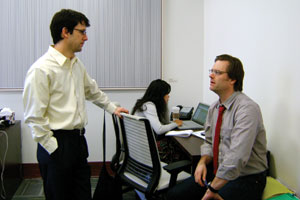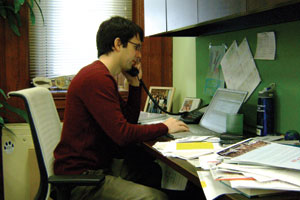Russell Unger, executive director of the New York Chapter of the U.S. Green Building Council, wants to make green building the norm in New York City.


To date, most green buildings in New York are high-end, private-sector projects built as prototypes. “This is great as an initial driver for green building, but we have not impacted general building in the city,” Unger says.
Unger and his organization are embarking on initiatives designed to tell New Yorkers why and how to build green.
The job isn’t easy. “When you are trying to change something and make a difference, there is no end to what you can do, but there are limits to your resources,” Unger says.
His challenge is juggling the myriad of projects under way without dropping any of the balls. He credits his staff for keeping him on track.
Before becoming executive director in 2007, Unger worked in the New York City Mayor’s Office of Contract Services as the assistant director and special counsel for environmental procurement. He was responsible for implementing the city’s environmentally preferred purchasing program.
The preferred purchasing legislation was written by Unger when he served as special adviser on sustainable development to then-City Council Speaker Gifford Miller and as legislative counsel for three City Council committees.
“I don’t know if getting hired to implement the law was meant as a complement or a punishment,” he jokes. “It was a wonderful experience to see something taken from conception as an idea, to a bill, to a law and then seeing what it actually takes to implement the legislation.”
During his four years with the City Council, Unger drafted and led negotiations on numerous environmental laws, including the city’s green building law, which was passed in January 2007 as Local Law 86.
On the Job
The particular Wednesday I tagged along with Unger was typical of most of his days, filled with a mix of green-building events, in-person meetings, conference calls and mountains of e-mails.
The day starts at 8:30 in the training room at Bovis Lend Lease’s Park Avenue office where Unger moderates an educational session, “Weathering the Storm,” intended to help design firms survive and thrive during the recession. This is one of 80-plus educational programs USGBCNY is running this year.
Robert Fox, partner at Cook + Fox, New York, kicks off the session by discussing lessons he learned during the last four recessions. A brainstorming session follows, with Unger eliciting ideas from the attendees on sharing information, pooling resources and cutting costs.
Next stop is the New York State Association for Affordable Housing Conference at the Marriott Marquis in Times Square, where Unger is a panelist at a workshop on utilizing green materials in affordable housing.
Unger tells the audience that it’s possible to build green and stay within budget, but there have to be some tradeoffs. “Green building faces two challenges, costs and expertise,” he says.
Unger adds that green products will cost more as long as green building remains a niche practice with only a subset of the construction industry using the products. He says mandates requiring green building are needed because they will increase the demand for green products and drive down their costs.
Returning to his office, Unger shifts his attention to the task list on his BlackBerry. “I have a running to-do list with enough to keep three people busy for a week,” he says.
Today’s priorities include calling prominent industry people to pitch speaking engagements...

Post a comment to this article
Report Abusive Comment